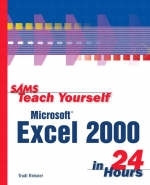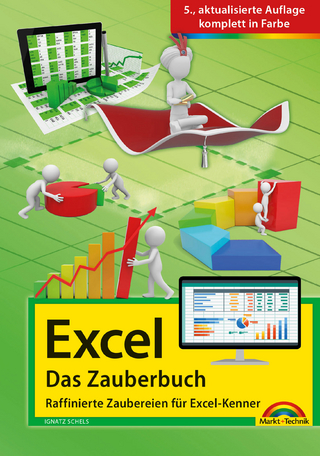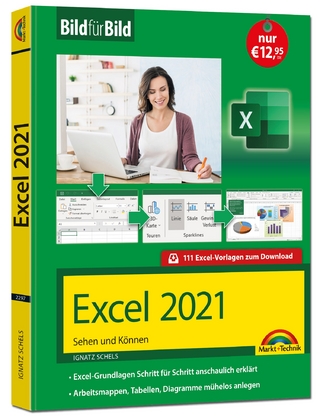
Sams Teach Yourself Microsoft Excel in 24 Hours
Sams Publishing (Verlag)
978-0-672-31445-2 (ISBN)
- Titel ist leider vergriffen;
keine Neuauflage - Artikel merken
PLEASE PROVIDE
Sams Teach Yourself Microsoft Excel 2000 in 24 Hours presents the best tools, shortcuts and ways to accomplish the most common tasks in Excel while avoiding the little used features. You may work at your own pace through the book in the one-hour lessons on the most widely used features of Excel.
(NOTE: Each chapter concludes with a Summary and Q&A.)I. EXCEL BASICS.
Hour 1. Getting Started.
What is Excel? Planning Strategies for Excel Worksheets. Starting Excel. Looking at the Excel Screen. Working with Toolbars. Using Excel Menus and Dialog Boxes. Getting the Most Out of Help. Moving Within a Workbook.
Hour 2. Entering Data.
Typing Data in a Cell. Entering Labels. Automating Your Work. Creating a Simple Spreadsheet. Entering Values. Adding Dates and Times. Copying from Cell to Cell. Making Changes to the Worksheet. Working with Rows and Columns.
Hour 3. Organizing Your Files.
Saving Your Workbook. Saving Your Work for the First Time. Saving Your Work Later. Understanding Excel Filenames. Protecting Your Work with AutoSave. Saving an Existing Workbook with a New Name. Protecting Your Files. Other Save Options. Rearranging Your Files.
Hour 4. Managing Your Files and Workbooks.
Creating a Blank Workbook. Opening an Existing Workbook. Searching for the Right File. Working with Workbooks and Worksheets. Getting a View of the Workbook. Using Ranges. Changing Worksheet Views. Workbook and Worksheet Navigation Tools.
Hour 5. Letting Excel Do the Math.
Why Use Formulas? How Formulas Work. Creating a Simple Formula. Referencing Cells. Using Range Names in Formulas. Using Relative and Absolute Addressing. Working with Formulas That Reference Other Workbooks and Worksheets Copying Formulas. Troubleshooting Formula Errors.
Hour 6. Using Excel Templates.
What is a Template? Exploring Excel Templates. Creating Your Own Template. Saving a Worksheet as a Template.
Hour 7. Printing Your Workbook.
The Value of Hard Copy. Checking Your Spelling Before You Print. Setting Up Your Page. Adding Headers and Footers. Choosing What to Print. Controlling Where Pages Break. Printing What You Want.
II. DRESS UP YOUR WORK.
Hour 8. Changing the Appearance of Text.
Formatting Your Text. Using Fonts. Changing Cell Alignment. Rotating Cell Entries. Centering a Heading. Controlling the Flow of Text. Copying Formatting with the Format Painter. Removing Formatting. Adjusting Column Width. Altering Row Height. Working with Comments.
Hour 9. Changing the Look of Values.
What Formats are Available? Choosing a Number Style. Working with Decimal Places. Designing Custom Numeric Formats. Formatting Conditionally. Hiding Zeros. Working with Dates.
Hour 10. Adding Borders, Colors, and Fills.
Have it Your Way. Changing the Color of Cell Entries. Adding Borders to Cells and Ranges. Working with Fills, Shading, and Color. Formatting with AutoFormat.
III. INTERACTIVE DATA BRINGS YOUR WORKSHEET ALIVE.
Hour 11. Working with Graphics Objects.
What is a Graphics Object? Why Use Graphics? Using the Drawing Toolbar. Adding Clip Art. Adding Special Effects with WordArt. Combining Multiple Objects. Manipulating Graphics Objects. Deleting Graphics Objects.
Hour 12. Adding a Chart.
Why Use a Chart? Chart Elements. Types of Charts. Creating Charts with the Chart Wizard. Working with Charts. Chart Formatting Techniques. Pulling a Pie Slice from a Chart.
Hour 13. Other Types of Charts.
Creating Other Chart Types. Creating an Excel Map. Using the Map Toolbar. Working with a Map. Using the Show/Hide Microsoft Map Control Dialog Box. Changing the Map Shading. Adding Additional Elements to the Map.
IV. ADVANCED EXCEL TECHNIQUES.
Hour 14. Working Smarter.
Working with Multiple Workbooks. Creating Links Between Worksheets and Workbooks. Customizing Excel. Protecting Your Data. Using Excel Add-ins.
Hour 15. Using Functions.
Advantages of Excel Functions. Financial Functions. Date and Time Functions. Logical Functions. How to Use Lookup Functions.
Hour 16. Auditing and Validating Your Work.
Auditing Workbooks. Validating Input. Using Named Constants and Formulas. Defining Label Ranges.
Hour 17. Analyzing Your Data.
Using the Scenario Manager. Using the Goal Seek Tool. Creating a Custom Report.
Hour 18. Working with Pivot Tables.
What is a Pivot Table? Learning the PivotTable Lingo. Building a Pivot Table. Modifying a Pivot Table. Working with Pivot Table Reports. Building a Pivot Chart.
Hour 19. Integrating Excel with Other Office Applications.
Using Objects in Excel. Inserting Objects. Using Hyperlinks with Other Office Documents. Sending Your Document Via Email with Outlook.
Hour 20. Automating Tasks with Macros.
What is a Macro? Creating a Macro. Running the Macro. Fixing Macro Errors. Attaching a Macro to a Toolbar. Using a Macro in Other Workbooks. Understanding Macro Viruses.
V. CREATING AND USING DATABASES IN EXCEL.
Hour 21. Building an Excel Database.
Basic Database Concepts. Starting with a Plan. Creating a Database. Entering and Adding Data. Searching for Data. Saving the Database.
Hour 22. Working with Your Database.
Working with Subtotals. Using Advanced AutoFilter Functions. Setting a Criteria Range. Retrieving Data with the Query Wizard. Choosing a Data Source. Saving Data Queries.
VI. AT THE OFFICE AND ON THE INTERNET/INTRANET.
Hour 23. Sharing Your Work with Your Colleagues.
What is a Network? Sharing Workbooks. Setting Up a Shared Workbook. Opening a Shared Workbook. Tracking Changes in Your Worksheet.
Hour 24. Worksheets and the Web.
What is the Internet? Using Internet Explorer 5.0. Searching on the Web. Adding a Hyperlink to a Worksheet. Saving Excel Documents to the Web. Posting Your Worksheet to the Web.
Appendix A. What's New in Excel 2000.
Standard and Formatting Toolbars. Menus with a Different Look and Feel. Office Assistants Galore. Clipboard Toolbar. Inserting Photographs. Organization Charts. Pivot Tables and PivotCharts. Excel and the Web. Email from Excel.
Index.
| Erscheint lt. Verlag | 18.5.1999 |
|---|---|
| Verlagsort | Indianapolis |
| Sprache | englisch |
| Maße | 231 x 186 mm |
| Gewicht | 771 g |
| Themenwelt | Informatik ► Office Programme ► Excel |
| ISBN-10 | 0-672-31445-2 / 0672314452 |
| ISBN-13 | 978-0-672-31445-2 / 9780672314452 |
| Zustand | Neuware |
| Informationen gemäß Produktsicherheitsverordnung (GPSR) | |
| Haben Sie eine Frage zum Produkt? |
aus dem Bereich


